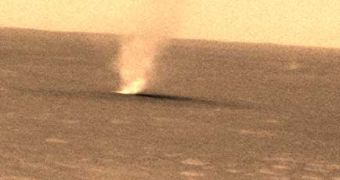The Red Planet is full of natural phenomena that are somewhat bizarre, considering the fact that Mars' atmosphere is less than 1 percent as dense as Earth's. But why do these strange phenomena occur, sometimes far more violent than similar ones in the much thicker atmosphere on Earth?
Storms are the most energetic phenomena on the surface of Mars and have been observed since the 1970s by the Viking probes. During that decade Mars experienced several large wind storms that stirred up bright, shiny dust particles and redistributed them around the planet.
Recently, a gigantic storm covered large areas of the surface and had the potential to cover the entire planet. In 2001, a massive dust storm actually engulfed the entire planet, obscuring its surface for days.
These storms appear when the planet is closest to the Sun, which increases the overall temperature and produces huge winds that lift the dust into the atmosphere. But this is not what the strange Martian weather has to offer.
Another strange apparition is a dust devil, a mini tornado that spins on the Martian surface. Though these dust devils seem to have random appearances, with no obvious tornado clouds to generate them, a recent one, captured on camera by Spirit rover was acting very strange, collapsing right in front of the rover, like a ghost being exorcised.
Such dust devils are found on Earth, too, but the atmospheric conditions varying so much, astronomers don't know exactly how they can form. In fact, no general predictive model for Martian weather was produced so far, despite 43 years of Mars exploration. The peak of these activities is recorded during summers, that begin in the southern hemisphere when Mars tilts away from the Sun. During a hot summer day, temperatures can reach 27 degrees Celsius (80 Fahrenheit), much like a warm day on Earth, while during Martian nights, it can drop to -118 Celsius (-180 F).
It's these dramatic temperature changes that give birth to the strange dust devils, which form when the Sun warms the cold ground, producing hot air that quickly rises and pulls in surrounding air and dust particles. The most powerful dust devils have been recorded to spin at 112 km/h (70 mph), like the beginning speed of hurricane wind.
Other strange features are the icy clouds of carbon dioxide that form when the planet is far away from the sun. They're like cirrus clouds on Earth and float at a very high altitude.
In fact, the only thing that keeps Mars weather from becoming even more violent is the lack of water, which, through evaporation and condensation, fuels hurricanes and rain on Earth. So, if there had been any liquid water on the surface sometime in the past, then Mars would have really been a raging planet.

 14 DAY TRIAL //
14 DAY TRIAL //